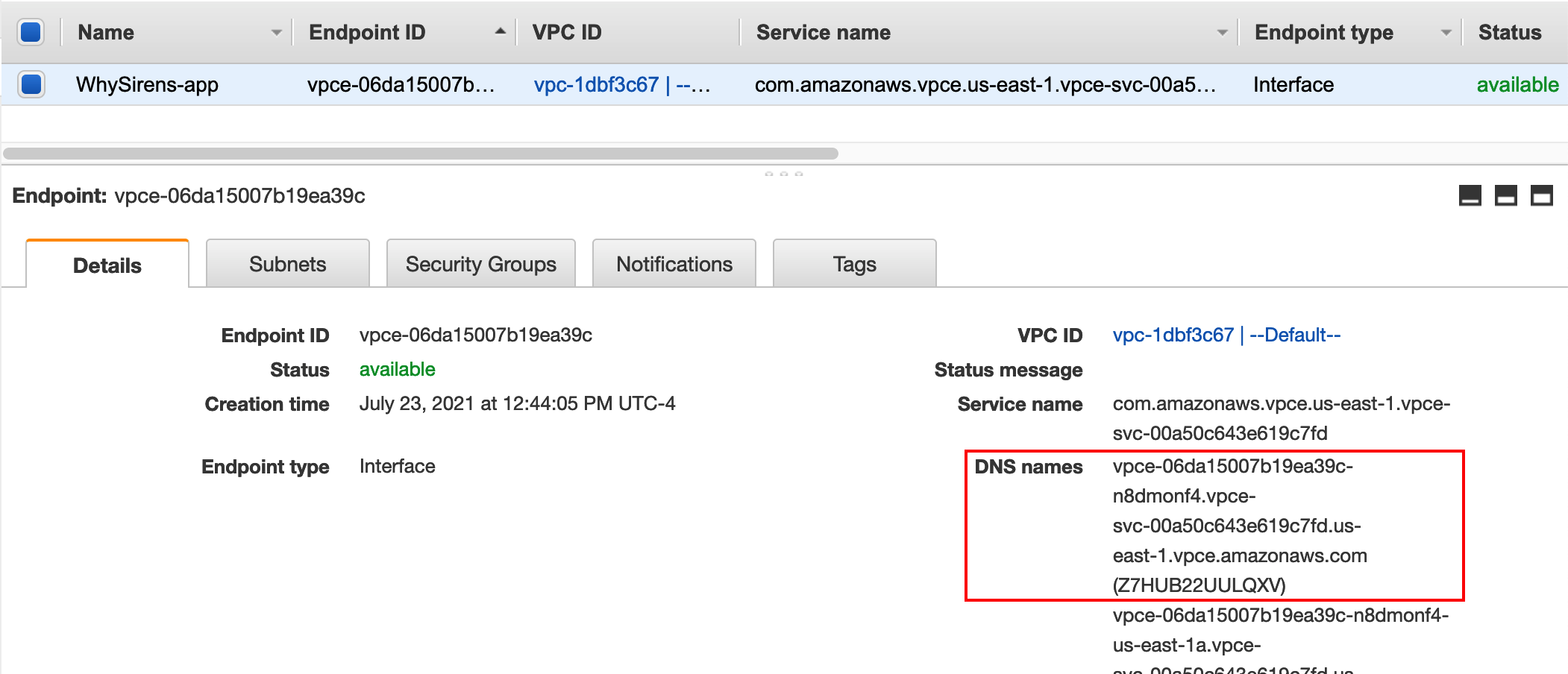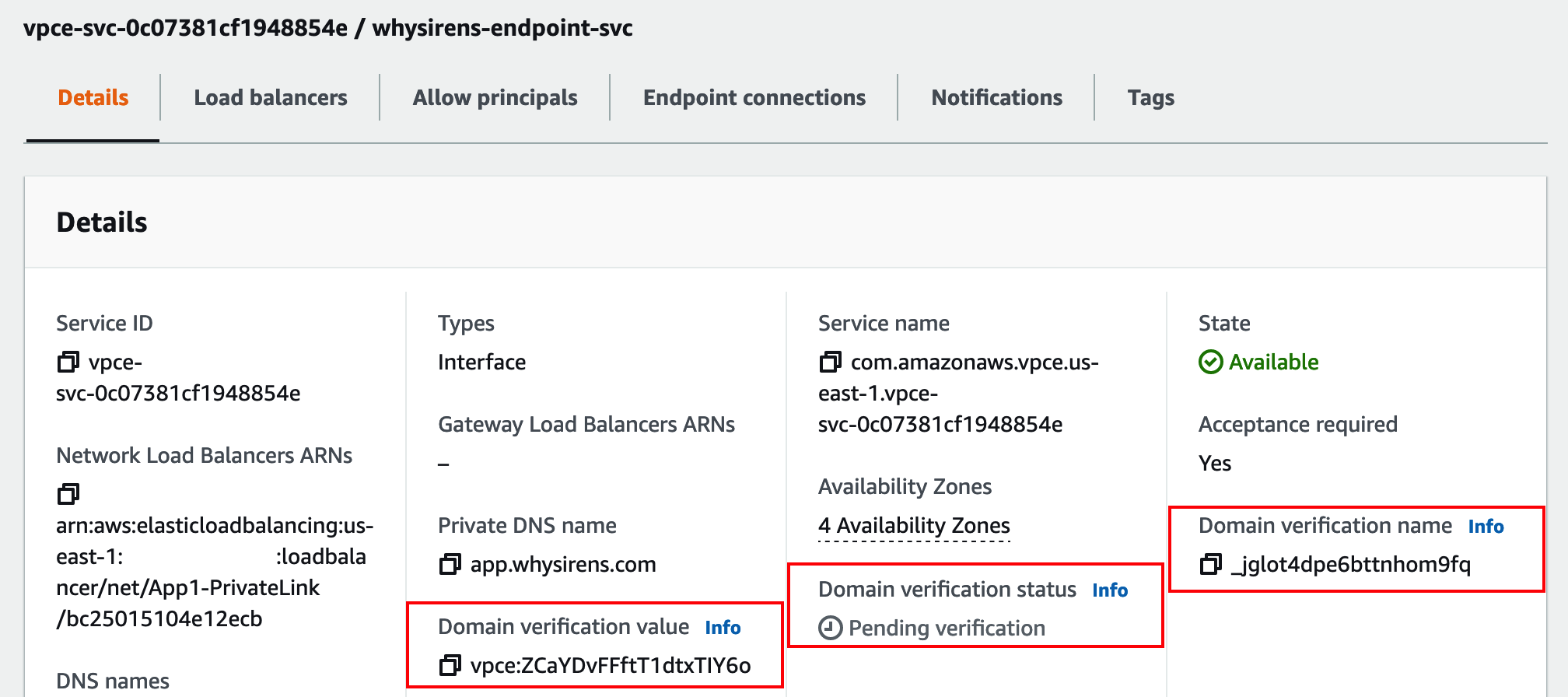Setting up Private DNS with AWS PrivateLink
Private DNS for AWS PrivateLink is a feature that allows you to create private, custom DNS names for internal or third-party PrivateLink services. In this post, we’ll look at an example using WhySirens.com, the premier webapp that tells you why you’re currently hearing police, fire, or ambulance sirens.
As part of the WhySirens service offering, customers (consumers) with an AWS presence can access their WhySirens data via PrivateLink. Currently WhySirens service consumers need to either use the default endpoint DNS name - and potentially recode their applications to do so - or configure a private hosted zone with ALIAS records if they want to resolve a friendly name like app.whysirens.com to the PrivateLink endpoint.
Instead of making their service consumers do the work, let’s walk through how WhySirens can create a privately-resolvable DNS name, i.e. app.whysirens.com, for their consumers to use to connect to the PrivateLink service.
- Review the setup
- Add private DNS in the provider account
- Enable private DNS in the consumer account
- Wrapping Up
Review the setup
In the consumer account, we’ll review the existing VPC endpoints. Make a note of the DNS names associated with the endpoint in the console:

You can also use the CLI:
$ aws ec2 describe-vpc-endpoints --query 'VpcEndpoints[*].DnsEntries'
If you have multiple endpoints in your consumer VPC, it might be challenging to parse the output. To filter to VPC endpoint service interfaces, use the following filters: aws ec2 describe-vpc-endpoints --filters "Name=vpc-endpoint-type,Values=Interface" "Name=service-name,Values=*vpce-svc*"
Doing a dig on the first resulting DNS name shows the corresponding endpoint IP addresses within the consumer VPC:
$ dig +short vpce-04f8bfb4666fccc60-nkf8dj4z.vpce-svc-0c07381cf1948854e.us-east-1.vpce.amazonaws.com
172.31.6.226
172.31.46.173
In addition to the main DNS entry, our PrivateLink endpoint also has AZ-specific DNS records (us-east-1a, us-east-1b, etc.) - performing a dig against those will return the individual IPs associated with those ENIs.
The DNS records created with a VPC endpoint are not private - querying those records from a host outside of the VPC (e.g. your local machine) will return the private IP addresses. This might seem like a security risk, but in practice there’s not much an attacker can do with this information. There’s nothing in the record that ties the IP address to an AWS account, IAM role, VPC, or other identifying data. An attacker would also need to know the entire (randomized) FQDN of the endpoint to even query it!
Performing a query against app.whysirens.com returns an NXDOMAIN:
$ dig app.whysirens.com
# <...output truncated>
;; Got answer:
;; -\>\>HEADER\<\<- opcode: QUERY, status: NXDOMAIN, id: 1586
;; flags: qr rd ra; QUERY: 1, ANSWER: 0, AUTHORITY: 1, ADDITIONAL: 1
Add private DNS in the provider account
In the provider account console, select the endpoint service, then under Actions, choose “Modify private DNS name”:

Enable the private DNS name by entering the domain - in this example, we want consumers to use app.whysirens.com - and save the changes:

Alternately, from the CLI:
# List the current endpoint services - note the ServiceId
aws ec2 describe-vpc-endpoint-service-configurations
# Add the private DNS name
aws ec2 modify-vpc-endpoint-service-configuration --service-id vpce-svc-0c07381cf1948854e --private-dns-name app.whysirens.com
In order to verify that you actually own the domain being used for the private DNS, AWS provides you with a TXT record to add to your domain’s DNS servers (TXT records - literally “text” records - are commonly used for domain ownership verification, spam prevention, etc.). AWS then will periodically query your domain’s DNS servers for the presence of this record. You won’t be able to use the private DNS name until this domain name verification check completes successfully.

The instructions for adding the TXT record will differ depending upon your DNS provider - for a Route 53 managed domain, you can add a TXT record in the console, or upload a JSON file via CLI. Other generic instructions can be found here.
Route 53: Because TXT records are double-quoted strings, you’ll need to escape the quotation marks in the resource record value field, e.g. "\"mystring\"", when creating the JSON file.
Verify that the TXT record was created successfully by performing a dig against the FQDN - you should see the string value returned:
$ dig +short -t TXT _vdufhro3v7skf8zxqqp5.whysirens.com
"vpce:x17K4W0MTcUJR42my2xm"
Once the TXT record is created, AWS will need to complete the verification process in order to enable the private DNS name. AWS doesn’t provide a time estimate, but in my experience this usually takes no more than 15 minutes at most if you’ve created the TXT records correctly (this is where you get up and get a coffee, water, etc.). You can also manually initiate the verification process from the console or CLI.
Enable private DNS in the consumer account
Now that the private DNS name enabled in the provider account, we can enable the private DNS name for the endpoint in the consumer account as well.

From the CLI:
aws ec2 modify-vpc-endpoint --vpc-endpoint-id vpce-04f8bfb4666fccc60 --private-dns-enabled
The status in the console ("State" in the CLI) will change to “pending” - this won’t interrupt connectivity to the existing DNS names - and then to “available” once the change completes. Performing a dig from an EC2 instance in the VPC to app.whysirens.com will now show the endpoint IPs:
$ dig +short app.whysirens.com
172.31.6.226
172.31.46.173
Unlike the default endpoint DNS record, this private DNS name will NOT be resolvable from outside of the VPC. This is because the private DNS name is created in an AWS-managed Route 53 private hosted zone associated with the VPC. As the service provider, the WhySirens team can use the same private DNS name for multiple endpoint services if needed.
Wrapping Up
In this post we walked through setting up a private DNS name for a PrivateLink service. While the consumer account could set up a private hosted zone app.whysirens.com with an ALIAS record to the endpoint, this removes the burden from the customers and provides a better experience with the WhySirens service.
A few final thoughts:
- Keep in mind the documented considerations around the domain name verification process - you’ll need to complete this process for each endpoint service, even if they share the same private DNS name.
- Performing the domain verification against a wildcard domain, e.g.
*.app.whysirens.com, will create a resolvable private DNS name for both the domain and any subdomains (app.whysirens.com,my.app.whysirens.com, etc.) - Because this setup creates a private hosted zone associated with the endpoint VPC, other VPCs won’t be able to natively resolve the private DNS name. For cross-VPC resolution via peering or Transit Gateway, check out this AWS blog post.